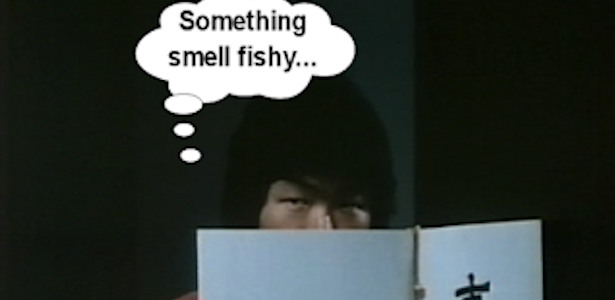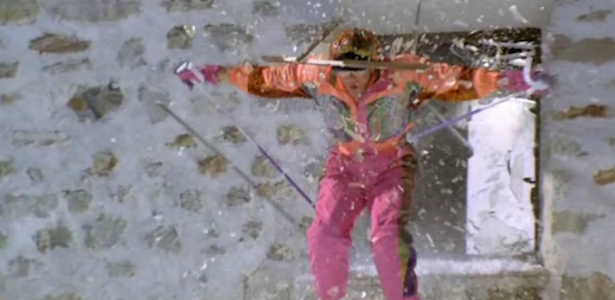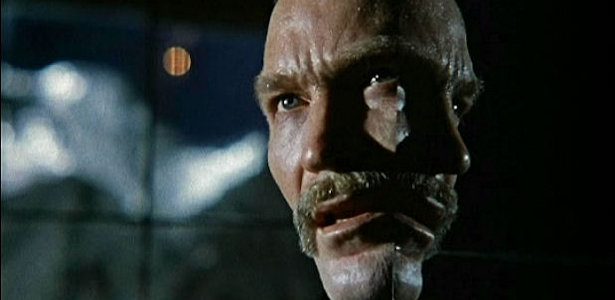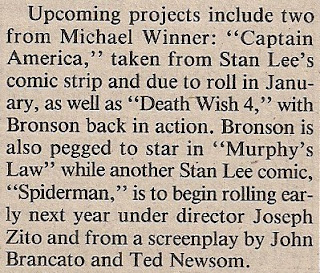With Steve Rogers throwing his mighty shield at audiences this weekend in CAPTAIN AMERICA: THE FIRST AVENGER, we figured it would be time to examine the unmade cinematic adventures of one of America’s most iconic comic book heroes. Born in the minds of Joe Simon and Jack Kirby in 1940, Captain America made his comic book debut in March 1941. And this wasn’t any normal superhero unveiling as the premiere issue had him punching Adolf Hitler in the face. While historians like to cite things like a withering armed forces and undermining subordinates for Der Führer’s downfall, I bet it was seeing the image of getting socked by a guy in red, white and blue tights that really did him in. Rumor has it Hitler was found clutching a weathered copy of Captain America #1 in his bunker after his suicide. Or maybe not.
Now here is some useful knowledge in case you ever find yourself cornered on the street and asked, “Which Marvel character was the first adapted into film?” It was Captain America. Perhaps still feeling his patriotic usefulness, Republic Pictures brought the character to life on the big screen with a 15-part serial in 1944. Sure, they changed a lot of it around (he was now a District Attorney named Grant Gardner), but the character was there in all of his glory. Well, kind of as star Dick Purcell was kind of chubby (he actually passed away shortly after finishing filming this serial). But audiences did get to see a live-action version of their hero complete with the star on the chest and winged mask emblemized with the trademark A. Not surprising, World War II ended a year and a half after this came out. Coincidence? I don’t think so.
After a re-release of the serials in 1953, development of live-action Captain America adaptations ceased, frozen like America’s superhero in a block of ice. With Richard Donner’s SUPERMAN (1978) proving that audiences for superheroes did exist, Captain America was thawed and made into a live-action superhero again. Unfortunately, it was for two abysmal TV movies for CBS with Reb Brown cast as the daring Cap. The less said about these films the better as they seemed to get everything wrong, wrong, wrong. They even gave him a goofy motorcycle helmet. Seriously, check this guy out and tell me you totally couldn’t see him in a disco circa 1979. Even the folks on Broadway spent several years developing an unrealized Captain America musical through most of the 1980s...really! You can read all about that failed project at this link if you want (as Broadway ain't my specialty). Just for kicks though, here is an ad that the Broadway producers ran in the trades looking for kid dancers to be in their Captain America show. And, uh, wow...I'm speechless. If made, this could have been the 1980s SPIDER-MAN: TURN OFF THE DARK.
Surprisingly, these two misfires didn’t tarnish the comic hero’s legacy forever and the 1980s brought renewed interest in the character. Big spender producers Menahem Golan and Yorum Globus, co-owners of The Cannon Group, decided to get into the superhero business in a big way. In 1984 they secured the movie rights for both Spider-Man and Captain America from Marvel Comics for the sweet sum of $225,000 for a 5-year deal. This was back before Hollywood went gaga over every comic book character. All of that changed the after the summer of 1989 with the release of BATMAN and cinema hasn’t been the same since. Anyway, Cannon – notorious for their 20-page spreads in Variety film market issues – wasted no time in announcing their live-action CAPTAIN AMERICA film project. Here is their first full-page ad for it from an issue dated October 24, 1984. The only information gleaned from the ad is that the screenplay was going to be by James R. Silke. He had previously delivered a trio of action scripts for Cannon in REVENGE OF THE NINJA (1983), SAHARA (1983) and NINJA III (1984). Damn, I bet he had Captain America fighting ninjas. Sign me up!
Seven months later in May 1985, the Go-Go boys debuted this eye-catching color ad in a Variety Cannes spread. It is the exact same design as before, but with some addition production info. Marvel big wigs James Galton and Joseph Calamari are now credited as executive producers and the ad inexplicable says it is “based on Stan Lee’s Marvel comic strip character.” Those words got Marvel into a wee bit of legal trouble and let’s just say you don’t see that credit in their ads ever again.
In the same issue’s profile on Cannon, there is a small little blurb about their two-picture deal with Marvel Comics.
Further production developments occurred in the fall of 1985 as Cannon unveiled a huge two-page ad announcing that British helmer Michael Winner would be directing the project. Winner had done several films for Cannon, most notably the first two DEATH WISH sequels. In the same October 16 issue, Cannon declared that filming would begin in January 1986.
January 1986 came and went with no film start as behind the scenes turmoil took over. Director Winner opted to drop the Silke script and wrote his own version with British TV writer Stan Hey. Marvel exec Galton was not pleased as a December 1985 letter to Golan reveals (the full letter can be seen here). He calls Winner and Hey’s screenplay “bloody awful,” “convoluted” and “totally implausible.” I guess he didn’t like it? He also suggests going “back to the drawing board again to get a more credible script.”
In February 1986, Cannon ran the following bland ad for the upcoming film with some major changes. First, it now declares it is “based on the Captain America comic book character” (wink, wink). And now we have a new trio of screenwriters attached: Michael Winner, crime novelist Lawrence Block and – surprise, surprise – Stan Lee! They literally did go back to the drawing board as Lee had made his debut in the comic field as the text filler in issue #3 of Captain America in May 1941. He also oversaw the CA line in the late 60s and early 70s for a 41 issue run (which is why a lot of people conflate him with having created the character).
Amazingly, this production never got going after Cannon actually missed a payment to Marvel Comics in 1986 and briefly lost the movie option rights. Finances (or the lack thereof) would play a major role in this film non-filming. Winner eventually left the project, but did stick around Cannon to make APPOINTMENT WITH DEATH (1988).
Word on the live-action CAPTAIN AMERICA was silent for most of 1986, but the project reared its patriotic head again in May 1987. Cannon once again trotted out that same Captain America image to announce the film would be moving forward with some brand new players. Proclaiming to be “based on the characters created by Stan Lee” (clever how they got around that), this version promised a script by Stephen Tolkin and direction from John Stockwell. Tolkin had earned his Cannon cred by doing an un-credited rewrite on their live-action MASTERS OF THE UNIVERSE (1987). Stockwell, at the time, was mostly an actor and is probably best known to audiences as the best friend in CHRISTINE (1983). He had just transition to directing with the Cannon high school action flick UNDER COVER (1987).
A June 1987 start date was promised and, once again, principal photography never materialized. As mentioned earlier, the company’s finances were in incredibly bad shape. Movie folks loved the pageantry of Golan and Globus and the Go-Go boys had no problem living up to their reputation as they spent millions upon millions upon their productions. The problem was none of their movies were making money and – according to this article in the same May 6, 1987 Variety issue – Cannon was in debt up to the jaw-dropping amount of $600,000,000. Yeah, you read that right, SIX HUNDRED MILLION DOLLARS!
Golan eventually left Cannon in 1989, with the French company Pathé with Italian financier Ginacarlo Parretti at the helm taking control of the fading studio. As part of a severance package, Golan was given control of 21st Century Film Corporation, another film entity Parretti had purchased before bankruptcy. And one of the projects Golan carried over to his new company was the long-in-development CAPTAIN AMERICA.
Another carryover from the Cannon era was hardworking director Albert Pyun. Pyun had delivered 5 feature films for Cannon and also helped out on their troubled JOURNEY TO THE CENTER OF THE EARTH (1989). Towards the end of Cannon’s life, he was also seemingly their go-to director on everything of note including their long-gestating SPIDER-MAN, MASTERS OF THE UNIVERSE 2, SPITFIRE: DELTA FORCE II and SUPERMAN V. We were lucky enough to chat briefly with Pyun via email and he gave us the lowdown on how the live-action CAPTAIN AMERICA finally got off the ground at 21st Century.
VJ: Around what time did you come onto the CAPTAIN AMERICA project?
Pyun: When Menahem Golan was leaving Cannon to start 21st Century, I asked him to take CAPTAIN AMERICAN with him. I grew up a big fan of the comic book and I wanted to convey the character that I grew up loving. That was 1989.
VJ: Did you get to read James Silke's screenplay for the proposed Michael Winner version?
Pyun: No I did not read it. I loved the screenplay I shot, written by Stephen Tolkin.
VJ: Who else tested or was considered for the lead role?
Pyun: Howie Long was tested. He did not fit the pre-experiment Steve Rogers. I had wanted two actors (pre-and-post experiment), but Marvel said, “No.”
VJ: 21st Century reportedly cut the budget on you while in production. What changes did you have to make?
Pyun: 21st Century lost their financing. I had to scale back the action and scramble for finishing funds. I made the most of it by going more deeply into Steve Roger's character.
VJ: Did you screen it at all for Marvel folks?
Pyun: I screened it for 21st Century and Columbia Tri-Star. Don't recall if Marvel was there.
VJ: What was their reaction?
Pyun: Crushing disappointment because they had wanted their expectations to be met even though they didn't bring the money.
Sadly, once again financial matters clipped Captain America’s little wings. CAPTAIN AMERICA was finished by 1990 with Golan’s 21st Century pimping the hell out of it in Variety (also note the banner for their unmade SPIDER-MAN film; you can read all about that film's convoluted history in "Never Got Made" file #19).
A proposed August 1990 theatrical release date came and went. Eventually the film went straight-to-video via Columbia Tristar Home Video in the United States, a poor fate not befitting America’s superhero. The Cap also suffered further indignity as Pyun’s film was taken out of his hands and edited down in the meantime. Thankfully, fans of Pyun’s film can now get a chance to see his version of the film as he has recently released his own director’s cut of the film on DVD and Bluray.
VJ: What can you tell us about the DVD release of your director's cut?
Pyun: I'm happy, after all these years, to be able to share my cut with fans. It has 13 minutes of scenes that were not in the released version. The story makes more sense now and Cap's struggle with what it means to be a hero and an American is more clearly understood. My cut is screening at the Austin, Alamo Drafthouse Ritz, Sunday July 18 at 10pm, Frightnight/Fandom Fest, Louisville, KY, July 22 at 5:30 pm, and Fantasia Film Fest in Montreal on August 6 at 11am. I will be at all the screenings for Q&A. Email curnanpictures@gmail.com for more info about the director’s cut.
Now here is some useful knowledge in case you ever find yourself cornered on the street and asked, “Which Marvel character was the first adapted into film?” It was Captain America. Perhaps still feeling his patriotic usefulness, Republic Pictures brought the character to life on the big screen with a 15-part serial in 1944. Sure, they changed a lot of it around (he was now a District Attorney named Grant Gardner), but the character was there in all of his glory. Well, kind of as star Dick Purcell was kind of chubby (he actually passed away shortly after finishing filming this serial). But audiences did get to see a live-action version of their hero complete with the star on the chest and winged mask emblemized with the trademark A. Not surprising, World War II ended a year and a half after this came out. Coincidence? I don’t think so.
After a re-release of the serials in 1953, development of live-action Captain America adaptations ceased, frozen like America’s superhero in a block of ice. With Richard Donner’s SUPERMAN (1978) proving that audiences for superheroes did exist, Captain America was thawed and made into a live-action superhero again. Unfortunately, it was for two abysmal TV movies for CBS with Reb Brown cast as the daring Cap. The less said about these films the better as they seemed to get everything wrong, wrong, wrong. They even gave him a goofy motorcycle helmet. Seriously, check this guy out and tell me you totally couldn’t see him in a disco circa 1979. Even the folks on Broadway spent several years developing an unrealized Captain America musical through most of the 1980s...really! You can read all about that failed project at this link if you want (as Broadway ain't my specialty). Just for kicks though, here is an ad that the Broadway producers ran in the trades looking for kid dancers to be in their Captain America show. And, uh, wow...I'm speechless. If made, this could have been the 1980s SPIDER-MAN: TURN OFF THE DARK.
Surprisingly, these two misfires didn’t tarnish the comic hero’s legacy forever and the 1980s brought renewed interest in the character. Big spender producers Menahem Golan and Yorum Globus, co-owners of The Cannon Group, decided to get into the superhero business in a big way. In 1984 they secured the movie rights for both Spider-Man and Captain America from Marvel Comics for the sweet sum of $225,000 for a 5-year deal. This was back before Hollywood went gaga over every comic book character. All of that changed the after the summer of 1989 with the release of BATMAN and cinema hasn’t been the same since. Anyway, Cannon – notorious for their 20-page spreads in Variety film market issues – wasted no time in announcing their live-action CAPTAIN AMERICA film project. Here is their first full-page ad for it from an issue dated October 24, 1984. The only information gleaned from the ad is that the screenplay was going to be by James R. Silke. He had previously delivered a trio of action scripts for Cannon in REVENGE OF THE NINJA (1983), SAHARA (1983) and NINJA III (1984). Damn, I bet he had Captain America fighting ninjas. Sign me up!
Seven months later in May 1985, the Go-Go boys debuted this eye-catching color ad in a Variety Cannes spread. It is the exact same design as before, but with some addition production info. Marvel big wigs James Galton and Joseph Calamari are now credited as executive producers and the ad inexplicable says it is “based on Stan Lee’s Marvel comic strip character.” Those words got Marvel into a wee bit of legal trouble and let’s just say you don’t see that credit in their ads ever again.
In the same issue’s profile on Cannon, there is a small little blurb about their two-picture deal with Marvel Comics.
Further production developments occurred in the fall of 1985 as Cannon unveiled a huge two-page ad announcing that British helmer Michael Winner would be directing the project. Winner had done several films for Cannon, most notably the first two DEATH WISH sequels. In the same October 16 issue, Cannon declared that filming would begin in January 1986.
January 1986 came and went with no film start as behind the scenes turmoil took over. Director Winner opted to drop the Silke script and wrote his own version with British TV writer Stan Hey. Marvel exec Galton was not pleased as a December 1985 letter to Golan reveals (the full letter can be seen here). He calls Winner and Hey’s screenplay “bloody awful,” “convoluted” and “totally implausible.” I guess he didn’t like it? He also suggests going “back to the drawing board again to get a more credible script.”
In February 1986, Cannon ran the following bland ad for the upcoming film with some major changes. First, it now declares it is “based on the Captain America comic book character” (wink, wink). And now we have a new trio of screenwriters attached: Michael Winner, crime novelist Lawrence Block and – surprise, surprise – Stan Lee! They literally did go back to the drawing board as Lee had made his debut in the comic field as the text filler in issue #3 of Captain America in May 1941. He also oversaw the CA line in the late 60s and early 70s for a 41 issue run (which is why a lot of people conflate him with having created the character).
Amazingly, this production never got going after Cannon actually missed a payment to Marvel Comics in 1986 and briefly lost the movie option rights. Finances (or the lack thereof) would play a major role in this film non-filming. Winner eventually left the project, but did stick around Cannon to make APPOINTMENT WITH DEATH (1988).
Word on the live-action CAPTAIN AMERICA was silent for most of 1986, but the project reared its patriotic head again in May 1987. Cannon once again trotted out that same Captain America image to announce the film would be moving forward with some brand new players. Proclaiming to be “based on the characters created by Stan Lee” (clever how they got around that), this version promised a script by Stephen Tolkin and direction from John Stockwell. Tolkin had earned his Cannon cred by doing an un-credited rewrite on their live-action MASTERS OF THE UNIVERSE (1987). Stockwell, at the time, was mostly an actor and is probably best known to audiences as the best friend in CHRISTINE (1983). He had just transition to directing with the Cannon high school action flick UNDER COVER (1987).
A June 1987 start date was promised and, once again, principal photography never materialized. As mentioned earlier, the company’s finances were in incredibly bad shape. Movie folks loved the pageantry of Golan and Globus and the Go-Go boys had no problem living up to their reputation as they spent millions upon millions upon their productions. The problem was none of their movies were making money and – according to this article in the same May 6, 1987 Variety issue – Cannon was in debt up to the jaw-dropping amount of $600,000,000. Yeah, you read that right, SIX HUNDRED MILLION DOLLARS!
Golan eventually left Cannon in 1989, with the French company Pathé with Italian financier Ginacarlo Parretti at the helm taking control of the fading studio. As part of a severance package, Golan was given control of 21st Century Film Corporation, another film entity Parretti had purchased before bankruptcy. And one of the projects Golan carried over to his new company was the long-in-development CAPTAIN AMERICA.
Another carryover from the Cannon era was hardworking director Albert Pyun. Pyun had delivered 5 feature films for Cannon and also helped out on their troubled JOURNEY TO THE CENTER OF THE EARTH (1989). Towards the end of Cannon’s life, he was also seemingly their go-to director on everything of note including their long-gestating SPIDER-MAN, MASTERS OF THE UNIVERSE 2, SPITFIRE: DELTA FORCE II and SUPERMAN V. We were lucky enough to chat briefly with Pyun via email and he gave us the lowdown on how the live-action CAPTAIN AMERICA finally got off the ground at 21st Century.
Pyun: When Menahem Golan was leaving Cannon to start 21st Century, I asked him to take CAPTAIN AMERICAN with him. I grew up a big fan of the comic book and I wanted to convey the character that I grew up loving. That was 1989.
VJ: Did you get to read James Silke's screenplay for the proposed Michael Winner version?
Pyun: No I did not read it. I loved the screenplay I shot, written by Stephen Tolkin.
VJ: Who else tested or was considered for the lead role?
Pyun: Howie Long was tested. He did not fit the pre-experiment Steve Rogers. I had wanted two actors (pre-and-post experiment), but Marvel said, “No.”
VJ: 21st Century reportedly cut the budget on you while in production. What changes did you have to make?
Pyun: 21st Century lost their financing. I had to scale back the action and scramble for finishing funds. I made the most of it by going more deeply into Steve Roger's character.
VJ: Did you screen it at all for Marvel folks?
Pyun: I screened it for 21st Century and Columbia Tri-Star. Don't recall if Marvel was there.
VJ: What was their reaction?
Pyun: Crushing disappointment because they had wanted their expectations to be met even though they didn't bring the money.
Sadly, once again financial matters clipped Captain America’s little wings. CAPTAIN AMERICA was finished by 1990 with Golan’s 21st Century pimping the hell out of it in Variety (also note the banner for their unmade SPIDER-MAN film; you can read all about that film's convoluted history in "Never Got Made" file #19).
A proposed August 1990 theatrical release date came and went. Eventually the film went straight-to-video via Columbia Tristar Home Video in the United States, a poor fate not befitting America’s superhero. The Cap also suffered further indignity as Pyun’s film was taken out of his hands and edited down in the meantime. Thankfully, fans of Pyun’s film can now get a chance to see his version of the film as he has recently released his own director’s cut of the film on DVD and Bluray.
VJ: What can you tell us about the DVD release of your director's cut?
Pyun: I'm happy, after all these years, to be able to share my cut with fans. It has 13 minutes of scenes that were not in the released version. The story makes more sense now and Cap's struggle with what it means to be a hero and an American is more clearly understood. My cut is screening at the Austin, Alamo Drafthouse Ritz, Sunday July 18 at 10pm, Frightnight/Fandom Fest, Louisville, KY, July 22 at 5:30 pm, and Fantasia Film Fest in Montreal on August 6 at 11am. I will be at all the screenings for Q&A. Email curnanpictures@gmail.com for more info about the director’s cut.








































































